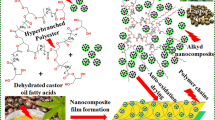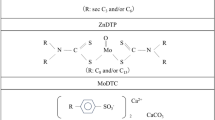Abstract
This study addresses the challenge of enhancing lubrication performance by exploring the potential of a protic ionic liquid (IL), [Oley][Oleic], in conjunction with carbon nanotube (CNT) mixtures. The primary objective is to determine the optimal CNT concentration that achieves effective lubrication for the IL-based lubricant. Through experimental investigation, notable reductions of 19.8 % in friction and 67.2% in wear are demonstrated when [Oley][Oleic] is blended with the optimum CNT concentration at 0.10 wt%. This study employs a friction-derived adsorption model to elucidate the underlying mechanisms of friction. The results indicate that the addition of CNTs leads to a larger adsorption surface coverage area of the lubricant molecules, resulting in decreased friction and wear. Synergistic attractive cooperative interactions among the IL molecules in the presence of CNTs are identified as a key factor in enhancing adsorption efficiency. These findings provide insights into the interaction between [Oley][Oleic] and CNTs when sheared, offering a predictive framework for understanding friction and wear behaviour specific to IL-based lubricants. By presenting a solution for reducing friction and wear, this study contributes to the development of energy-efficient and environmentally-friendly lubrication practices, opening avenues for further advancements in the field of lubrication and promoting sustainable tribological solutions for diverse applications.












Similar content being viewed by others
Data and code availability
Not applicable
References
Chong WWF, Ng JH, Rajoo S, Chong CT (2018) Passenger transportation sector gasoline consumption due to friction in southeast Asian countries. Energy Convers Manage 158:346–358
Bibra EM, Connelly E, Dhir S, Drtil M, Henriot P, Hwang I, Le Marois JB, McBain S, Paoli L, Teter J (2022) Global ev outlook 2022: Securing supplies for an electric future
Lugt PM (2016) Modern advancements in lubricating grease technology. Tribol Int 97:467–477
Chen Y, Jha S, Raut A, Zhang W, Liang H (2020) Performance characteristics of lubricants in electric and hybrid vehicles: a review of current and future needs. Front Mech Eng 6(571):464
He F, Xie G, Luo J (2020) Electrical bearing failures in electric vehicles. Friction 8:4–28
Van Rensselar J (2019) The tribology of electric vehicles. Tribol Lubricat Technol 75(1):34–43
Gunderson S, Fultz G, Snyder CE, Wright J, Gschwender L, Heidger S (2011) The effect of water content on the dielectric strength of polyalphaolefin (pao) coolants. IEEE Trans Dielectr Electr Insul 18(1):295–302
Hunt GJ, Gahagan MP, Peplow MA (2017) Wire resistance method for measuring the corrosion of copper by lubricating fluids. Lubr Sci 29(4):279–290
Lee CT, Lee MB, Mong GR, Chong WWF (2022) A bibliometric analysis on the tribological and physicochemical properties of vegetable oil-based bio-lubricants (2010–2021). Environ Sci Pollut Res 29(37):215–248
McGuire N (2017) Selecting lubricating greases: What you should know. Tribology & Lubrication Technology 73(10):38
Shah R, Woydt M, Zhang S (2021) The economic and environmental significance of sustainable lubricants. Lubricants 9(2):21
Beyer RM, Durán AP, Rademacher TT, Martin P, Tayleur C, Brooks SE, Coomes D, Donald PF, Sanderson FJ (2020) The environmental impacts of palm oil and its alternatives. Biorxiv pp 2020–02
Fan X, Xia Y, Wang L, Pu J, Chen T, Zhang H (2014) Study of the conductivity and tribological performance of ionic liquid and lithium greases. Tribol Lett 53:281–291
Vyavhare K, Aswath PB (2019) Tribological properties of novel multi-walled carbon nanotubes and phosphorus containing ionic liquid hybrids in grease. Front Mech Eng 5:15
Mu Z, Zhou F, Zhang S, Liang Y, Liu W (2005) Effect of the functional groups in ionic liquid molecules on the friction and wear behavior of aluminum alloy in lubricated aluminum-on-steel contact. Tribol Int 38(8):725–731
Jiménez A, Bermúdez M (2010) Ionic liquids as lubricants of titanium-steel contact. part 2: friction, wear and surface interactions at high temperature. Tribol Lett 37:431–443
Gusain R, Khatri OP (2016) Fatty acid ionic liquids as environmentally friendly lubricants for low friction and wear. RSC Adv 6(5):3462–3469
Bresme F, Kornyshev AA, Perkin S, Urbakh M (2022) Electrotunable friction with ionic liquid lubricants. Nat Mater 21(8):848–858
Rohlmann P, Black JJ, Watanabe S, Leckner J, Shimpi MR, Rutland MW, Harper JB, Glavatskih S (2023) Tribochemistry of imidazolium and phosphonium bis (oxalato) borate ionic liquids: Understanding the differences. Tribol Int 181(108):263
Jimenez AE, Bermúdez MD (2007) Ionic liquids as lubricants for steel-aluminum contacts at low and elevated temperatures. Tribol Lett 26:53–60
Qu J, Blau PJ, Dai S, Luo H, Meyer HM III, Truhan JJ (2009) Tribological characteristics of aluminum alloys sliding against steel lubricated by ammonium and imidazolium ionic liquids. Wear 267(5–8):1226–1231
Qu J, Blau PJ, Dai S, Luo H, Meyer HM (2009) Ionic liquids as novel lubricants and additives for diesel engine applications. Tribol Lett 35:181–189
Sharma V, Doerr N, Aswath PB (2016) Chemical-mechanical properties of tribofilms and their relationship to ionic liquid chemistry. RSC Adv 6(27):341–356
Pandey P, Somers AE, Hait SK, Forsyth M, Ramakumar SSV (2021) Short chain imidazolium ionic liquids: synthesis and oil miscibility in various base oil by use of surfactant as high performance friction and antiwear lubricant additive. Tribol Lett 69(3):95
Verma DK, Dewangan Y, Singh AK, Mishra R, Susan MABH, Salim R, Taleb M, El Hajjaji F, Berdimurodov E (2022) Ionic liquids as green and smart lubricant application: an overview. Ionics 28(11):4923–4932
Shi Y, Larsson R (2016) Non-corrosive and biomaterials protic ionic liquids with high lubricating performance. Tribol Lett 63:1–7
Flores-Torres S, Holt DGL, Carey JT (2018) Method for controlling electrical conductivity of lubricating oils in electric vehicle powertrains, US Patent App, 15:725-734
Taha-Tijerina J, Aviña K, Martínez JM, Arquieta-Guillén PY, González-Escobedo M (2021) Carbon nanotori structures for thermal transport applications on lubricants. Nanomaterials 11(5):1158
Singh PN, Saxena SA, Gangwar, (2021) Tribological aspect of nano-lubricant based on carbon nanotubes (cnts) and graphene?a review. Advances in Engineering Materials: Select Proceedings of FLAME 2020:pp 257–267
Pamies R, Avilés MD, Arias-Pardilla J, Carrión FJ, Sanes J, Bermúdez MD (2019) Rheological study of new dispersions of carbon nanotubes in the ionic liquid 1-ethyl-3-methylimidazolium dicyanamide. J Mol Liq 278:368–375
Gu Y, Ma L, Yan M, He C, Zhang J, Mou J, Wu D, Ren Y (2022) Strategies for improving friction behavior based on carbon nanotube additive materials. Tribol Int 175:107875
Ashour ME, Osman TA, Khattab A, Elshalakny AB (2017) Novel tribological behavior of hybrid mwcnts/mlngps as an additive on lithium grease. J Tribol 139(4):041–801
Thyashan N, Yu H, Liu X, Abeykoon C (2023) Ionic liquids modified cnts and graphene as additive in vegetable lubricating oil: a route for sustainable tribology. Results Surf Interf 11(100):119
Kasar AK, Reeves CJ, Menezes PL (2022) The effect of particulate additive mixtures on the tribological performance of phosphonium-based ionic liquid lubricants. Tribol Int 165(107):300
Cota I, Gonzalez-Olmos R, Iglesias M, Medina F (2007) New short aliphatic chain ionic liquids: synthesis, physical properties, and catalytic activity in aldol condensations. The Journal of Physical Chemistry B 111(43):12,468–12,477
Álvarez VH, Dosil N, Gonzalez-Cabaleiro R, Mattedi S, Martin-Pastor M, Iglesias M, Navaza JM (2010) Brønsted ionic liquids for sustainable processes: synthesis and physical properties. J Chem Eng Data 55(2):625–632
Hamrock BJ, Dowson D (1977) Isothermal elastohydrodynamic lubrication of point contacts: part iii - fully flooded results. J of Lubrication Tech
Wu CS, Klaus EE, Duda JL et al (1989) Development of a method for the prediction of pressure-viscosity coefficients of lubricating oils based on free-volume theory. ASME J Tribol 111(1):121–128
Lee CT, Lee MB, Chong WWF, Ng JH, Wong KJ, Chong CT (2022) Boundary lubricity of vegetable-oil-derived trimethylolpropane (tmp) ester. Lubricants 10(12):346
Meng F, Han H, Ma Z, Tang B (2021) Effects of aviation lubrication on tribological performances of graphene/mos2 composite coating. J Tribol 143(3):031401
Kurth TL, Byars JA, Cermak SC, Sharma BK, Biresaw G (2007) Non-linear adsorption modeling of fatty esters and oleic estolide esters via boundary lubrication coefficient of friction measurements. Wear 262(5–6):536–544
Parthasarathi NL, Borah U, Albert SK (2013) Correlation between coefficient of friction and surface roughness in dry sliding wear of aisi 316 l (n) stainless steel at elevated temperatures. Comput Modell New Technol 17(1):51–63
Mungse HP, Khatri OP (2014) Chemically functionalized reduced graphene oxide as a novel material for reduction of friction and wear. J Phys Chem C 118(26):14394–14402
Jahanmir S, Beltzer M (1986) An adsorption model for friction in boundary lubrication. ASLE Trans 29(3):423–430
Kreuzer HJ (1996) Theory of sticking: the effect of lateral interactions. J Chem Phys 104(23):9593–9612
Acknowledgements
This research project received financial support from both Universiti Teknologi Malaysia and the Ministry of Higher Education (MOHE) under the Fundamental Research Grant Scheme (FRGS) with the reference number FRGS/1/2023/TK10/UTM/02/3 and UTM Fundamental Research Grant with the reference number Q.J130000.3851.22H02 (PY/2022/00419).
Author information
Authors and Affiliations
Contributions
Conception: WWFC,MIHZ; Experimental design: CTL, MBL; Carrying out measurements: NAAMA, Chiew Tin Lee, Mei Bao Lee, Izzati Halid; Formal analysis and investigation: Nur Aisya Affrina Mohamed Ariffin, Izzati Halid, William Woei Fong Chong, Hedong Zhang; Writing—original draft preparation: Nur Aisya Affrina Mohamed Ariffin, William Woei Fong Chong; Writing—review and editing: Siti Hartini Hamdan, Muhammad Izzal Ismail, Hedong Zhang; Funding acquisition: William Woei Fong Chong; Resources: Siti Hartini Hamdan, William Woei Fong Chong; Supervision: Siti Hartini Hamdan, William Woei Fong Chong
Corresponding authors
Ethics declarations
Conflicts of interest
The authors declare that they have no known competing financial interests or personal relationships that could have appeared to influence the work reported in this paper.
Ethical approval
Not applicable
Additional information
Handling Editor: Annela M. Seddon.
Publisher's Note
Springer Nature remains neutral with regard to jurisdictional claims in published maps and institutional affiliations.
Rights and permissions
Springer Nature or its licensor (e.g. a society or other partner) holds exclusive rights to this article under a publishing agreement with the author(s) or other rightsholder(s); author self-archiving of the accepted manuscript version of this article is solely governed by the terms of such publishing agreement and applicable law.
About this article
Cite this article
Mohamed Ariffin, N.A.A., Lee, C.T., Lee, M.B. et al. Enhancing boundary friction and wear reduction through adsorption control in protic ionic liquid and carbon mixtures. J Mater Sci 59, 794–809 (2024). https://doi.org/10.1007/s10853-023-09257-x
Received:
Accepted:
Published:
Issue Date:
DOI: https://doi.org/10.1007/s10853-023-09257-x




